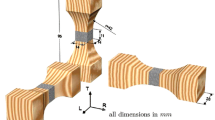Abstract
Dielectric properties of rubber wood have been studied at low and microwave frequencies with different moisture content and grain direction. The ultrasonic properties were studied with pulsed longitudinal waves of frequency 45 kHz, Two anisotropic directions have been considered for this study — parallel and perpendicular to grain. The low frequencies were of 0.01, 0.1, L0, 10 and 100 Hz and microwave frequencies were of 1, 2.45, 6, 8, 10, 14 and 17 GHz. The moisture content affected the dielectric constant and dielectric loss factor both at low and microwave frequencies? The moisture content above 30% showed little influence on dielectric properties whereas it increases linearly from 0 to 30% in both the grain directions at low frequencies. A continuous increase of dielectric properties was obtained with the increase of moisture content at microwave frequencies and the trend becomes concave upward. Dielectric properties increase as the frequencies increase except dielectric loss factor at microwave frequencies where reverse trends were observed. Little change of dielectric loss factor was obtained at frequencies above 6 GHz. The parallel to grain direction showed higher dielectric constant and dielectric loss factor compared to perpendicular to grain direction. This dielectric anisotropy of wood may be attributed due to the microscopic, macroscopic molecular as well as chemical constituents of wood. Ultrasonic properties were also affected considerably by the moisture content and grain direction. The dried wood showed higher ultrasonic velocity and elastic stiffness constant compared to green wood. The parallel to grain direction exhibits higher ultrasonic velocity and elastic stiffness constant than perpendicular to grain.
Zusammenfassung
Die dielektrischen Eigenschaften von Hevea brasiliensis wurden bei niedriger und Mikrowellenfrequenz sowie unterschiedlichen Feuchten und Faserrrichtungen untersucht. Die Ultraschalleigenschaften wurden mit gepulsten Longitudinalwellen von 45 kHz bestimmt. Beide Bestimmungen erfolgten parallel und senkrecht zur Faser. Als niedrige Frequenzen wurden 0,01, 0,1, 1,0, 10 und 100 Hz eingesetzt, im Mikrowellenbereich 1, 2, 4, 5, 6, 8, 10, 14 und 17 GHz. Die Feuchte beeinflußt die Dielektrizitätskonstante und den Verlustfaktor in beiden Frequenzbereichen. Zwischen 0 und 30% Feuchte steigt die Dielektrizitätskonstante bei niedrigen Frequenzen linear
Similar content being viewed by others
References
Bucur V (1983) An ultrasonic method for measuring the elastic constants of wood increment cores bored from living trees. Ultrasonic 21(3): 116–126
Bucur V (1988) Wood structural anisotropy estimated by acustic invariants. IAWA. Bulletin 9(1): 67–74
Bucur V, Feeny F (1992) Attenuation of ultrasound in solid wood. Ultrasonics. 30(2): 76–81
James WL, Hamil DW (1965) Dielectric properties of Douglus Fir measured at microwave frequencies. Forest Prod. J. 15(2): 51–56
James WL (1975) Dielectric properties of wood and hardboard. Variation with temperature, frequency, moisture content and grain direction. Res. Pap. USDA Forest Service. Forest Prod. Lab. Madison, Wisconsin
James WL (1977) Dielectric behaviour of Douglus-fir at various combination of temperature, frequency and moisture content. Forest Prod. J. 27(6): 44–48
James JF, Robert JR, Drum JR (1995) Nondestructive evaluation of honeycomb and surface checks in Red Oak lumber. Forest Prod. J. 45(5): 42–45
Kabir MF, Sidek HAA, Daud WM, Khalid K (1997) Detection of knot and split of rubber wood by non destructive ultrasonic method. Journal of Tropical Forest Product 3(1): 88–96
Kamioka H (1988) Effect of ultrasonic bonding materials on velocity and attenuation of sound in Red Lauan wood Jpn. J. Appl. Phys. 27(2): 188–191
Kroner K, Pungis L (1952) Zur dielektrischen anisotropic des natureholzes im frequenzbereich. Holzforschung 6(1): 13–16
Lin RT (1967) Review of the dielectric properties of wood and cellulose. Forest Prod. J. 17(7): 61–66
Mikhailovskaja KP (1972) Investigation of moisture characteristics of wood electric parameters. Author’s paper on Thesis for Candidate of Science degree, LTI, CBP, Leningrad, (in Russian)
Nanassy AJ (1972) Dielectric measurement of moist wood in a sealed system. Wood Sci. Technol. 6: 67–77
Nakamura N, Nanami N (1993) The sound velocity and moduli of elastic in the moisture desorption process of Sugi wood. Mokuzai Gakkaishi. 39(2): 1341–1348
Norimoto M, Yamada T (1970) The dielectric properties of wood IV. On the dielectric anisotropy of wood. Wood Res. 50: 36–49
Norimoto M, Yamada T (1972) The dielectric properties of wood VI. On the dielectric properties of the chemical constituent of wood and the dielectric anisotropy of wood. Wood Res. 52: 31–43
Norimoto M, Yamada T (1976) Dielectric properties of wood. Wood Res. 59/60: 106–152
Norimoto M, Hayashi S, Yamada T (1978) Anisotopy of dielectric constant in coniferous wood. Holzforschung. 32(5): 167–172
Parker ML, Kennedy RW (1973) The status of radiation densitimetry for measurement of wood specific gravity. Proc. IUFRO, Pretoria. 5(2): 882–893
Polge H (1984) Essais de caracterisation de la veine verte du merisier. Ann. Sci. For. 41: 45–58
Rafalski J (1967) Dielectric properties of compressed Beech wood. Forest Prod. J. 17(8): 64–65
Sakai H, Minamisawa A, Takagi K (1990) Effect of moisture content on ultrasonic velocity and attenuation in woods. Ultrasonics. 28: 382–385
Skaar C (1948) The dielectric properties of wood at several radio frequencies. NY State Coll. For. Syracuse NY, Tech. Pub. 69, 36 pp
Torgovnikov GI (1993) Dielectric properties of wood and wood based materials. Springer Verlag, New Work.
Tiuri MK, Jokela K, Heikkila S (1980) Microwave instrument for accurate moisture and density measurement of timber. Journal of Microwave Power. 15 (4): 251–254
Vermas HF (1974) Dielectric properties of Pinus pinaster as a function of its Alcohle-Benzen-soluble content. Wood Sci. 6(4): 363–367
Vermas HF (1976) The dielectric constant of solid wood substances calculated with two different methods. Holzforschung. 30(3): 97–98
Venkateswaran A, Tiwari SY (1964) Dielectric properties of moist wood. Tappi. 47(1):125–128
Author information
Authors and Affiliations
Rights and permissions
About this article
Cite this article
Kabir, M.F., Daud, W.M., Khalid, K. et al. Dielectric and ultrasonic properties of rubber wood. Effect of moisture content grain direction and frequency. Holz als Roh- und Werkstoff 56, 223–227 (1998). https://doi.org/10.1007/s001070050305
Issue Date:
DOI: https://doi.org/10.1007/s001070050305




